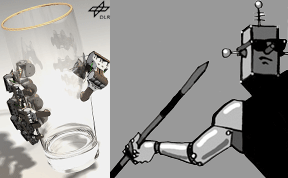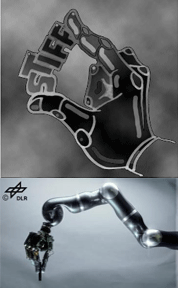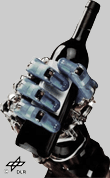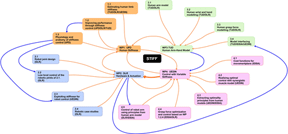

|
Part 1 (responsible: UPD)A major objective of the STIFF project is to understand how human beings benefit from stiffness control in different motor behaviours. Insights gained from studying human motor behaviour can then be transferred to artificial systems to see how performance might be improved in robotic systems and to determine the benefits of biomimetic actuators that allow for the control of passive stiffness properties. This part groups together the experimental studies to be carried out with healthy human volunteers. First, better estimates of the time-varying characteristics of human stiffness will be developed. Second, the study of human stiffness behaviour will be extended beyond what is currently known based on artificial laboratory tasks. Finally, we will look at the neural mechanisms underlying stiffness control in humans. These activities will have a close interplay with other Parts; human behaviour will inspire control schemes to be implemented on robotic systems while models of the human musculoskeletal system and implementations on robotics systems will be used to better understand the observed human behaviour. Human (stiffness) performance during the experiments will be quantified as a benchmark system for the robotic performance with and without the controller developed in Part 4. Part 2 (responsible: DLR)Building on a variable impedance integrated hand-arm system currently under development at DLR and funded elsewhere, this Part mainly deals with the challenge of (i) using variable impedance actuators and (ii) modelling the control and actuation in this novel robotic hardware. Optimal Control of this actuator system is investigated in detail (without considering optimality of stiffness at this stage) since doing this efficiently in a variable impedance scenario has not been investigated except in toy systems. Various demonstrator robotics tasks will be used to mimic and compare the results of the human impedance measurements in Part 1, including ball throwing. Part 3 (responsible: TUD)This Part deals with detailed modelling of the arm-hand musculoskeletal system with biomechanical fidelity. Why? Because we want to use results from the studies of Part 1 in a more quantitative framework that is conducive to optimization studies. The musculoskeletal model can be treated as a physically realistic plant (like a robot!) in which the geometric, actuator and reflexive properties are well-defined, from which the optimization principles and strategy can be gleaned (will be done in Part 4) based on movement study data from Part 1. Part 4 (responsible: UEDIN)This Part will first extract key optimality principles used in biological systems by combining data from the human studies (Part 1) in the context of the bio-mechanically realistic human arm models (Part 2). These optimality principles can then be implemented on (a kinematically slightly different) robotic variable stiffness system. This ensures that the mismatch between the exact human arm model and the tendon based robot arm is not an issue since we are extracting the principles. Higher level control goals will be specified through RL methodology followed by low level optimization of redundant joint angles and stiffness parameters based on the OFC framework. Results will be benchmarked with criteria developed in Part 1. |


| |



